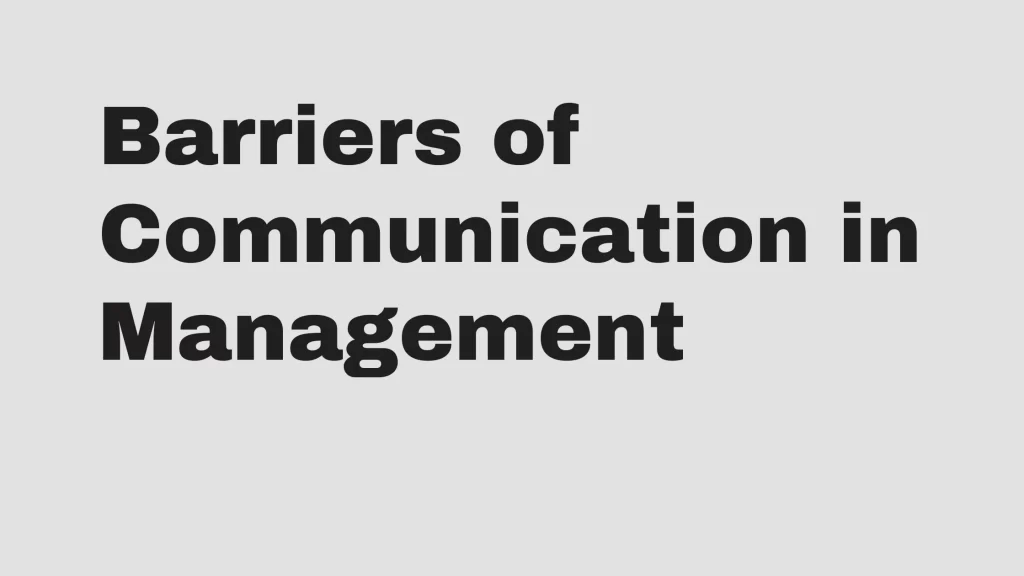Upward communication plays a pivotal role in the smooth operation of any business, acting as a bridge between employees and management. It’s not just about passing information; it’s about fostering an environment where ideas and feedback flow freely, leading to innovation and growth. However, this flow isn’t always smooth. Barriers to upward communication can stifle this exchange, leaving valuable insights unheard.
Barriers to upward communication include fear of retribution or backlash, as well as hierarchical structures that inhibit lower-level employees from freely expressing concerns, ideas, or feedback to higher-level management. Overly formal channels and lack of receptive attitudes from superiors can also deter open communication.
One of the biggest hurdles is the lack of confidence among employees, which often keeps them from speaking up. Add to this the fear of misrepresentation or the tendency to sugarcoat messages, and you’ve got a recipe for communication breakdown. Let’s dive into these barriers and explore how they can be dismantled to pave the way for more effective communication in the workplace.
Contents
Barriers to Upward Communication
In my years of experience, I’ve identified several key barriers that often hinder upward communication within organizations. It’s crucial to recognize these obstacles to foster an environment where ideas and concerns can flow freely from employees to management.
Lack of Trust
One of the primary barriers I’ve observed is a lack of trust between employees and their supervisors. This mistrust stems from a fear that their feedback or opinions won’t be valued or might even be used against them.
The consequences of this can be severe, with employees choosing to remain silent rather than sharing valuable insights.
To combat this, companies need to build a culture of respect and transparency. Open dialogue should be encouraged, and employees must feel that their voices are not just heard but also appreciated.
Fear of Retaliation
Fear of Retaliation is another significant barrier to effective upward communication. This fear is not unfounded, as employees often worry about the repercussions of voicing concerns, especially if it involves criticism of management practices or decisions. As a result, crucial feedback that could improve processes or resolve issues is often withheld.
Organizations must ensure that there are safe channels for employees to express their concerns without fear of negative consequences. This involves not only creating policies that protect employees but also actively demonstrating that feedback is welcome and valued.
Authoritarian Culture
An authoritarian culture can severely limit upward communication. In environments where hierarchy is strictly enforced, employees may feel intimidated or believe that their input is not desired or valued. This can lead to a disengaged workforce that is reluctant to share innovative ideas or feedback that could drive the company forward.
To address this, it’s important for leaders to foster a more inclusive and participatory culture. Encouraging participation in decision-making processes and recognizing contributions from all levels of the organization can help break down these barriers.
Understanding and addressing these barriers is essential for fostering a healthy communication environment. By recognizing the importance of trust, alleviating fears of retaliation, and dismantling authoritarian structures, companies can ensure that upward communication thrives. This not only improves morale but also leads to more innovative and responsive organizational practices.
Importance of Upward Communication

In today’s fast-paced business world, I’ve observed that upward communication is more than a mere conduit for information flow; it’s a crucial element that can significantly impact organizational success. As someone deeply involved in the dynamics of workplace communication, I’ve seen first hand how fostering these channels can transform an organization.
Employee Feedback
Firstly, let’s talk about Employee Feedback. I can’t stress enough how vital it is for management to actively seek and encourage feedback from their team members. Employees on the ground have a unique perspective on the daily operations, challenges, and potential improvements that can be made within an organization. By establishing open lines of communication, companies can tap into this wealth of insights. It’s not just about hearing what employees have to say; it’s about acting on it.
Consider Employee Engagement Statistics You Need to Know in 2020, which highlighted that while 60% of U.S. employees have the means to provide feedback, only 30% felt their feedback led to actionable change. This gap demonstrates a critical area for improvement in effectively utilizing upward communication.
Actionable feedback not only addresses immediate issues but also fosters an environment of respect and inclusivity, showing employees that their voices are valued and indispensable.
Innovation and Creativity
Moving on to Innovation and Creativity, there’s a direct link between these two elements and the effectiveness of upward communication. When employees feel safe and encouraged to share their ideas and feedback, it naturally leads to a culture of innovation.
Front-line employees are often the first to spot areas ripe for innovation or to come up with creative solutions to problems. By creating channels for these ideas to be shared with upper management, companies can stay ahead of the curve and continuously improve.
I’ve seen cases where a simple suggestion from an employee led to significant cost savings or created a new revenue stream. It’s a testament to the fact that great ideas can come from anywhere within an organization if there’s a supportive environment for sharing them.
Organizations that prioritize upward communication not only benefit from a practical standpoint but also position themselves as forward-thinking and employee-centric.
In my journey exploring various facets of business communication, I’ve come to realize that the potential of upward communication in driving employee engagement, innovation, and overall organizational growth is immense. It’s not just about breaking down barriers; it’s about building bridges that foster a vibrant, open, and innovative workplace culture.
Overcoming Barriers

Building Trust
Building trust within an organization is fundamental to overcoming the barriers to upward communication. Trust forms the foundation upon which open and honest communication can occur. When employees feel trusted, they’re more likely to share their thoughts, ideas, and concerns without fear of negative repercussions. To build this trust, I’ve observed that it’s crucial for management to consistently act with integrity, show respect to all employees, and follow through on commitments.
Another effective strategy is to create opportunities for employees to get to know their managers and leaders on a more personal level. This could involve informal coffee chats, team-building activities, or company retreats. When employees see their leaders as approachable and understanding, it bridges the gap and fosters a culture of trust.
Moreover, acknowledging and acting on feedback is a powerful way to demonstrate that employee input is valued. When people see their ideas lead to tangible changes or improvements, it not only boosts morale but also reinforces the belief that their contributions can make a difference.
Encouraging Open Communication
Encouraging open communication is another critical step in overcoming barriers to upward communication. This means creating a culture where sharing feedback, asking questions, and voicing concerns are not only accepted but encouraged.
One approach I’ve found effective is implementing regular feedback sessions. These sessions can be structured as one-on-one meetings between employees and their direct supervisors, or as part of team meetings where everyone is encouraged to share their input openly.
Utilizing technology can also play a significant role in facilitating open communication. Tools such as anonymous feedback platforms or forums can provide employees with a safe space to express their thoughts without fear of judgement. It’s important, however, that the feedback collected through these channels is addressed appropriately to ensure employees feel heard.
Training managers and leaders on the principles of active listening and empathetic communication can further promote an environment of open communication. When employees feel listened to and understood, it strengthens their trust in leadership and the organization as a whole.
By focusing on building trust and encouraging open communication, organizations can effectively overcome the barriers to upward communication. These efforts lay the groundwork for a more engaged, motivated, and efficient workforce.
Barriers to Upward Communication in the Workplace
When it comes to fostering a culture of open communication within an organization, understanding the barriers to upward communication is essential. In my experience, selective perception and information overload stand out as significant hurdles in the workplace.
Selective perception refers to the natural human tendency to filter information based on past experiences and personal needs. This process, while a necessary adaptation to manage the vast amounts of stimuli we encounter daily, can also lead to critical feedback being overlooked or misinterpreted.
As employees attempt to communicate their insights and suggestions upward, their messages may get lost or distorted through the lens of selective perception held by their supervisors or managers.
Another pervasive challenge is information overload, a phenomenon well-documented in both academic and professional circles.
The modern workplace is rife with streams of data and messages vying for attention. From emails and reports to meetings and notifications, the sheer volume of information can be overwhelming.
This state of constant bombardment often leads to crucial pieces of communication being missed or ignored, as individuals struggle to process and prioritize the influx of data. Experts have linked information overload to a decrease in efficiency, creativity, and mental well-being.
| Barrier | Impact |
|---|---|
| Selective Perception | Critical feedback overlooked or misinterpreted |
| Information Overload | Decrease in efficiency, creativity, and mental well-being |
To navigate these barriers, it’s important to cultivate an environment where open dialogue is encouraged, and where systems are in place to efficiently manage the flow of information.
Encouraging small group discussions, utilizing communication platforms judiciously, and training leaders in active listening are just a few strategies that can mitigate the effects of these challenges.
By acknowledging and addressing these barriers head-on, organizations can take significant steps toward improving upward communication and, by extension, their overall operational success.
Conclusion
Tackling the hurdles of selective perception and information overload is crucial for fostering effective upward communication in any organization.
By embracing strategies that promote open dialogue and active listening, we’re not just breaking down these barriers; we’re building a foundation for enhanced operational success.
It’s about creating a culture where every voice is heard and valued. The journey toward better communication is ongoing, but with the right approach, the benefits are within reach. Let’s commit to making these changes, for the sake of our teams and the future of our workplaces.
Boko Ducky has over 10 years of experience in helping individuals and organizations improve their communication skills.



